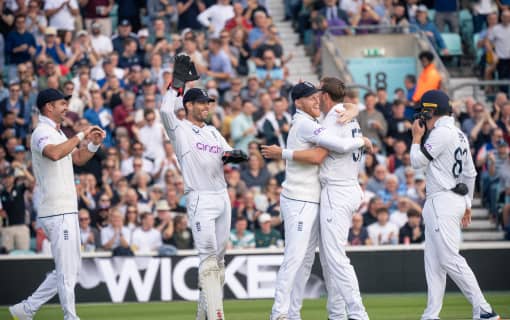Test cricket is like a main course, and will always be. The other versions are like starters and desserts. If you asked 10 cricketers I wouldn't be surprised if eight say that Test cricket is at the top - Sachin Tendulkar
(estimated 6 minute read)
Cricket can be quite a confusing sport – from ridiculous sounding fielding positions like gully, backward square leg, and silly point to a range of formats like Twenty20 (T20 or IT20 for international matches), One Day Internationals (ODI’s) and Test Matches, deciphering the intricacies of international cricket can be quite the minefield! With England’s record breaking recent win against Pakistan in Rawalpindi and a highly anticipated Ashes Series next summer, what better time to brush up on your Test cricket knowledge?
International cricket is contested across three formats: IT20, ODI and Test Matches, with IT20 and ODI being the shorter formats of the game. In IT20 matches, teams have 20 overs each to bat and bowl, whereas ODI cricket is slightly longer with each team receiving 50 overs.
Test Matches on the other hand are what many players, pundits and fans alike consider the ‘purest form of the game’ – it is the original form of international cricket, the ‘long format’ of the game. Test Cricket represents the ultimate battle between batsmen and bowler and Test Match history is littered with some incredible duels that only materialise due to the length of the game. Think Viv Richards v Dennis Lillee in the 70’s and 80’s, Sachin Tendulkar v Glenn McGrath in the 90’s and more recently Andrew ‘Freddie’ Flintoff’s battle with Ricky Ponting during the 2000’s, especially in the memorable 2005 Ashes campaign.
SO, WHERE WAS THE FIRST Test Match PLAYED?
Despite the first ever international Test Match being contested between an Australian Combined XI and a team of visiting English professionals in 1877 at the Melbourne Cricket Ground (MCG), Test cricket is quintessentially English – what other sport breaks mid-afternoon for a tea break and can last up to five days and still end in a draw or be abandoned without a ball being bowled!?
Sound a bit daft? Well, with each team receiving two innings to accumulate a runs total and bowl out opposition batsmen over the five allocated days, a range of factors can come into play which ultimately decide the length of the game.
HOW LONG DOES A TEST MATCH actually LAST?
Annoyingly for those of you that like a hard stop to your sporting occasions, when answering the question of how long a Test Match lasts, the best answer we can offer is “it depends”! Tactics, weather, field conditions, geographical location, form of players and umpiring decisions all play a role and until spikes tread turf, the final length of any Test Match is unknown.
In Test cricket, the play usually lasts for about 7 hours and 30 minutes each day and the matches are played over 5 days, with a minimum of 90 overs bowled in each day. Every match consists of four innings with both teams batting twice, but the match may end without all four innings being played if a team is unable to bowl the opposition all out, or the duration of the match ends, due to weather interruptions.
Play may be extended for an additional half an hour on a particular day if the minimum numbers of overs are not bowled or if there is a possibility of a result on the final day’s play.
Each day is split into three sessions of game with tea or lunch break between the sessions. The time breakdown of Test Matches on each day is as follows –
- Session 1 – 2 hours of play
- Lunch – 40 minutes
- Session 2 – 2 hours of play
- Tea – 20 minutes
- Session 3 – 2.5 hours of play
Test Cricket is mostly played in the daytime. In the Indian sub-continent, matches are usually played between 9 AM to 5 PM whereas in England, Australia, and New Zealand the play takes place between 11 AM to 7 PM. Day-night Test Matches have however been a recent addition and are mostly played as one-off matches. These day-night test matches start around 2 PM and last until 10 PM in the evening.
WHAT WAS THE LONGEST TEST MATCH IN HISTORY?
Prior to 1939, some Test Matches were allocated as ‘timeless Tests’ whereby the game is played to a conclusion regardless of how many days that took! In quite absurd circumstances, the ‘timeless Test between England and South Africa in Durban became the longest in history. The game started on 3 March 1939, with play continuing on the 4th, 6th, 7th, 8th, 9th, 10th, 13th, and 14th. Play on the 11th was abandoned due to rain giving 9 days of actual play and 10 days of scheduled play!
By the evening of 14 March England were 316 & 654–5 chasing South Africa’s 530 & 481, needing just 42 more runs for victory. However, after all that toil in the South African sun, England needed to leave Durban the following day to catch their boat home, so, despite being a ‘timeless Test’, a draw was agreed! Not surprisingly after this insane match, ‘timeless Tests’ have not been played since.
WHAT WAS THE SHORTEST Test match IN HISTORY?
The shortest Test match, in terms of actual playing time, was the first Test between England and Australia at Trent Bridge on 12 June 1926. There were only 50 minutes play in which 17.2 overs were bowled and England scored 32-0, with the Nottingham weather curtailing the rest of the game.
In terms of balls bowled, the shortest is the first Test between the West Indies and England at Sabina Park, Jamaica on 29 January 1998. Only 10.1 overs were bowled in 56 minutes and England scored 17-3. The match was abandoned as the pitch was deemed to be too dangerous to continue.
In both instances, the matches were of course drawn but the shortest ever fully completed Test Match was the fifth, and final, Test between Australia and South Africa at the Melbourne Cricket Ground (MCG) in February 1932. Ironically, for a so-called ‘timeless’ match, it was all over in five hours and 53 minutes, albeit spread over three days, with a rest day in between, and a total of just 109.2 overs (656 balls) played. South Africa batted first and were bowled out for a paltry 32, with skipper Jock Cameron top-scoring with 11 runs…the only batter to get into double figures.
For Australia, Bert Ironmonger took 5 wickets for 6 runs, while Laurie Nash returned figures of 4 for 18. Thanks to an innings of 40 by Alan Kippax and 42 by Jack Fingleton, Australia replied with 153 in 54.3 overs. For South Africa, Sandy Bell, Neville Quinn, and Quintin McMillan took three wickets each. In their second knock, the tourists were bowled out for 45, rendering Australia the winners by an innings and 72 runs.







